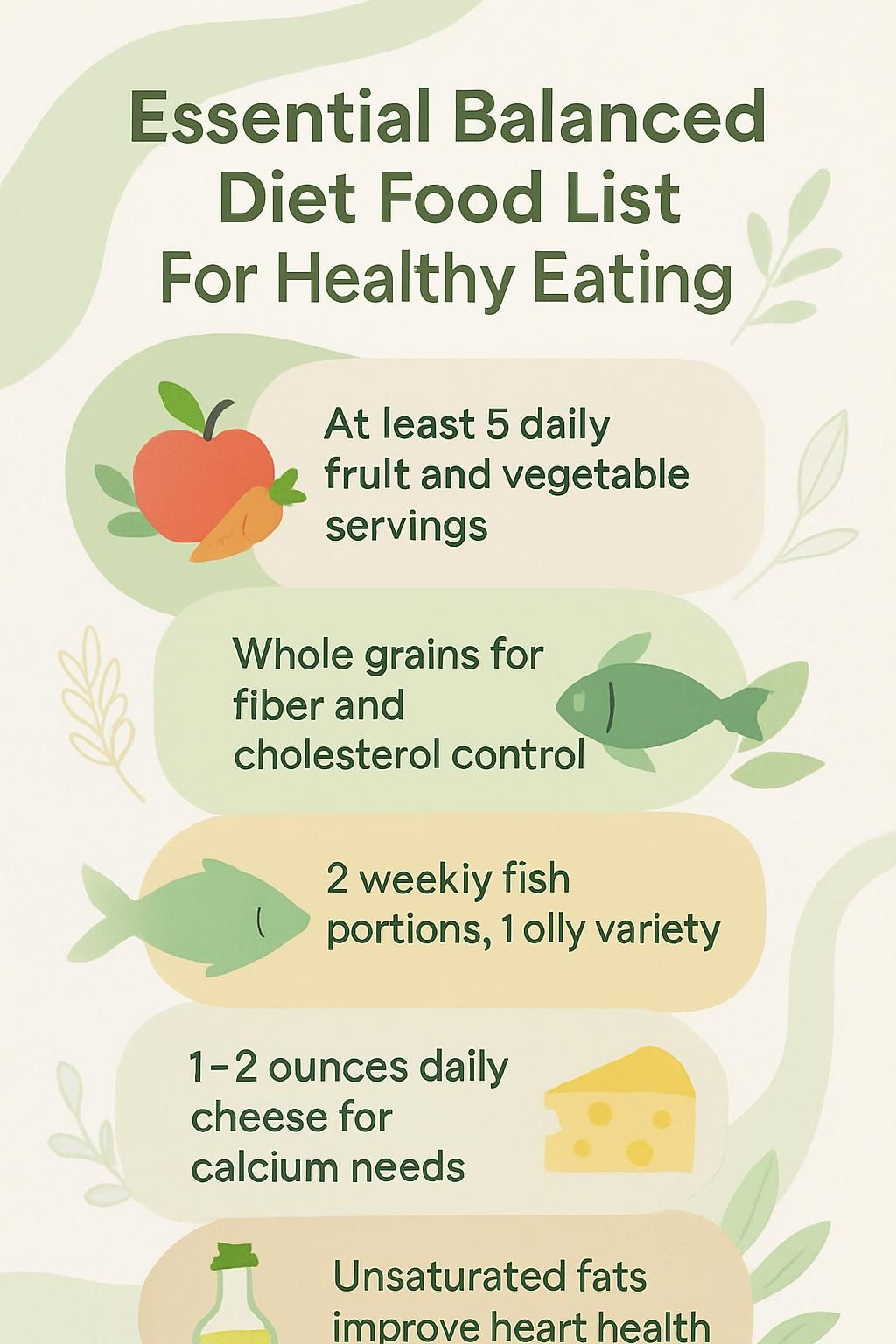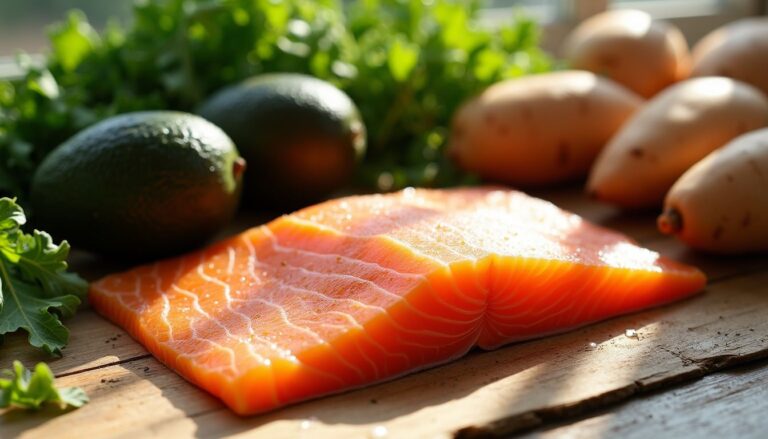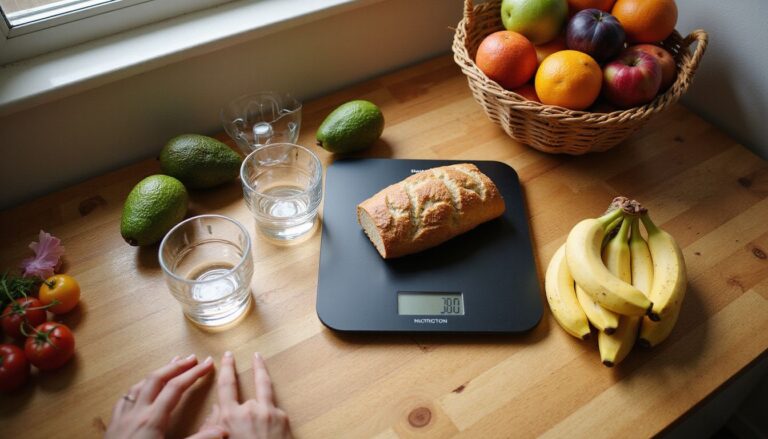Essential Balanced Diet Food List For Healthy Eating
Our Nutrition Assistant AI Suite will transform your body. You will lose fat, get toned, and build muscle. Gain confidence and optimal health.
You want to feel good, have steady energy, and protect your health. A balanced diet gives you a simple way to choose healthy foods without guessing. Research shows that eating from each food group helps you maintain a healthy weight and lowers disease risk¹.
This Balanced Diet Food List highlights smart picks in fruits, vegetables, whole grains, protein foods, and dairy. You will see which swaps matter most and how small daily changes can add up over time. Use it as a friendly guide for healthy eating, one meal at a time.
¹NHS Eatwell Guide: https://www.nhs.uk/live-well/eat-well/food-guidelines-and-food-labels/the-eatwell-guide/
Key Takeaways
- Eat at least five servings of different fruits and vegetables each day as the NHS Eatwell Guide suggests¹. This habit supports a healthy weight and cuts chronic disease risk.
- Choose whole grains like oatmeal and brown rice for more fiber, vitamins, and minerals. These support digestion and help manage cholesterol.
- Pick lean protein sources such as skinless poultry, fish, eggs, beans, and soy foods. Aim for two portions of fish weekly, with one oily fish serving.
- Use low-fat dairy or calcium-fortified plant drinks to meet calcium needs while keeping saturated fat low. Keep cheese to about 1–2 ounces daily.
- Add unsaturated fats from olive oil, avocados, nuts, and seeds for heart health. Diets rich in these foods have shown lower cardiovascular risk in recent studies.
¹NHS Eatwell Guide: https://www.nhs.uk/live-well/eat-well/food-guidelines-and-food-labels/the-eatwell-guide/
What is a balanced diet?

A balanced diet means eating a variety of foods in the right amounts each day. It includes all five food groups, which are fruits, vegetables, grains, protein foods, and dairy or alternatives.
Try to eat at least five portions of different fruits and vegetables daily, a key step in the Eatwell Guide. Base meals on high fiber starchy foods such as potatoes with skin, whole wheat bread, brown rice, or whole grain pasta.
Add protein from poultry, fish, eggs, beans, or lentils, and include dairy or fortified plant drinks. Choose unsaturated fats from vegetable oils, nuts, and seeds, and limit saturated fat from butter and processed meats.
Keep salt and sugar low to protect blood pressure and heart health. Children under two have different needs. After that, they can move toward family meals that follow these proportions for growth and development.
How does a balanced diet support healthy living?
Eating a balanced diet gives your body vitamins, minerals, protein, healthy fats, and fiber. Getting five daily servings of produce links with lower risk of heart disease, stroke, obesity, and some cancers.
Cutting saturated fat helps manage cholesterol, which lowers cardiovascular risk. Many adults live with overweight. A BMI check can help you set a goal weight and track progress.
Whole grains steady blood sugar and support digestion. Healthy eating patterns also boost energy and immune function. A quick example, one of my students swapped soft drinks for water and noticed fewer afternoon slumps.
Low-fat dairy offers calcium without too much saturated fat. Oily fish like salmon supply omega-3 fatty acids, a type of fat that supports heart health.
As one nutritionist said,
A balanced diet is not about restriction but about making smarter everyday choices.
Eating across all five food groups supports bones and muscles in growing kids and helps adults reach or keep a healthy body weight.
Essential food groups in a balanced diet
You need different foods from each group to cover vitamins, minerals, and fiber. Use this section to build variety that fits your routine.
Which fruits and vegetables should I include?
Fruits and vegetables should make up just over one third of your daily intake. Variety matters because each color adds different nutrients.
- Eat a colorful mix, like apples, bananas, oranges, berries, grapes, and citrus. Aim for at least five servings daily.
- Choose leafy greens such as spinach, kale, and lettuce. They supply B vitamins, iron, and fiber.
- Add cruciferous vegetables like broccoli and cauliflower for vitamins C and K and protective plant compounds.
- Include starchy vegetables, for example sweet potatoes or carrots, to add fiber and slow-release carbs.
- Use fresh, frozen, or canned in juice to keep variety year-round.
- Limit fruit juice or smoothies to one 150 ml glass per day to avoid excess sugar.
- Think portions, 80 g for produce, 30 g for dried fruit, and keep dried fruit to mealtimes.
- Mix vegetables to broaden antioxidants, like pairing spinach with tomatoes or carrots.
- Choose berries often for vitamins and antioxidants that may support heart health.
These habits support growth in children and protect health at any age.
Why are whole grains important?
Whole grains keep the bran and germ, so they deliver more fiber, vitamins, and minerals than refined grains. They help you feel full longer and support gut health.
Make starchy foods just over one third of your intake and pick whole grain most often. Keep potato skin for extra fiber. Type matters more than total carbs. For example, oats and whole wheat offer more nutrition than white bread.
Switching a sugary cereal to oatmeal can steady morning energy because oats digest slowly. Whole grains also supply essential fatty acids in small amounts and fit into any meal plan.
What protein options work for every meal?
Protein helps build and repair tissue. It also supports immune health and keeps you full.
- Lean meats like skinless chicken give protein, iron, zinc, and B vitamins with less fat.
- Processed meats such as bacon or sausages are high in saturated fat and salt. Limit them.
- Eat two portions of fish weekly, with one serving from oily fish like salmon or sardines for omega-3 fats.
- Eggs work at any meal and cook quickly.
- Beans and lentils bring plant protein and fiber. Add them to soups, salads, or tacos.
Rotating sources keeps meals interesting and helps cover minerals like iron.
What are dairy and suitable alternatives?
Milk, yogurt, and cheese provide protein and calcium for bones and teeth. Choose low-fat or fat-free versions to reduce saturated fat.
If you avoid dairy, pick calcium-fortified plant drinks such as soy beverages or fortified yogurts. Check labels, not all plant milks have enough calcium or protein. Tofu set with calcium sulfate can also help you meet needs.
| Dairy Foods | Protein (g per cup) | Calcium (mg per cup) |
|---|---|---|
| Cow’s Milk | 8 | 300 |
| Yogurt | 10–12 | ~250 |
| Cheddar Cheese (1 oz) | 7 | ~200 |
| Suitable Alternatives | Protein (g per cup) | Calcium Added? |
|---|---|---|
| Fortified Soy Drink | 7–9 | Yes |
| Almond or Cashew Drink | <2 | Check label |
| Oat Drink | ~2–4 | Check label |
For snacks, choose low-sugar yogurt or a piece of fruit instead of sweetened drinks high in calories.
How do I include healthy fats?
Use oils and spreads made from olives, avocados, or sunflowers. These are rich in unsaturated fats, which support heart health.
- Cook with olive oil instead of butter.
- Snack on a small handful of nuts or seeds like almonds, peanuts, or chia seeds.
- Add sliced avocado to sandwiches or salads.
- Limit highly processed snacks that pack trans fat and saturated fat.
- Check labels for palm oil, which can raise saturated fat intake.
Good guideline, 25–35 percent of daily calories can come from fats, but keep portions modest since all fats are calorie dense.
Best fruits and vegetables for optimal health
Colorful produce brings vitamins, minerals, and fiber that your body uses every day. Think of your plate as a simple color chart.
What are common fruits like apples, bananas, and oranges?
These staple fruits are budget friendly and easy to find year-round. Each one brings a different benefit.
- Apples supply about 4 grams of fiber per medium fruit plus vitamin C and antioxidants.
- Bananas provide potassium for normal heart function and vitamin B6 for energy use.
- Oranges deliver over 60 mg of vitamin C per medium fruit along with fiber.
- Use standard portions, 80 g for fresh or frozen, 30 g for dried, and no more than 150 ml juice daily.
- They are naturally low in sodium and saturated fat.
- Apples make a crisp snack, bananas help after a workout, and oranges brighten breakfast.
- Choose versions packed in juice, not syrup, if buying canned.
Which leafy greens provide the most nutrients?
Leafy greens are nutrient dense, meaning they deliver many nutrients per calorie. Rotate types to get full coverage.
- Kale is rich in fiber, vitamin C, and vitamin K. One cup can exceed daily vitamin K needs.
- Collard greens provide calcium and vitamin A and rank high in nutrient density studies.
- Swiss chard carries magnesium, iron, potassium, vitamin E, and vitamin K.
- Turnip greens are strong in folate and antioxidants.
- Romaine and green leaf lettuce offer light, crunchy options that fit lower calorie plans.
- Spinach brings plant iron plus vitamins A and C, and it mixes well in smoothies or omelets.
Many people report steadier energy after adding leafy salads several days a week.
What are crucial vegetables like broccoli and cauliflower?
Broccoli and cauliflower are cruciferous vegetables that pack fiber, vitamins, and special plant chemicals that support heart health.
- Broccoli offers fiber, vitamin C, and vitamin K. One cup has about 2.5 grams of protein and 31 calories.
- Cauliflower is low in calories, about 25 per cup, yet rich in vitamin C and folate.
- Regular intake of cruciferous vegetables links with lower risk of chronic illness, including heart attack.
- Fiber in these vegetables supports healthy digestion and steadier blood sugar.
- Steam, roast, or grill them. Grilling adds a nutty taste while keeping texture.
- Pair them with lean protein like grilled chicken or sardines for a filling meal.
- Broccoli contains sulforaphane, a plant compound studied for its protective effects since the 1990s.
Try roasted broccoli tossed over a lunch salad for satisfying crunch and lasting energy.
Why are berries like blueberries and strawberries beneficial?
Berries bring a compact package of fiber, vitamin C, and antioxidants that protect cells.
- Blueberries can help support blood pressure and heart health according to 2022 research.
- Strawberries are low in calories and carbohydrates yet high in vitamin C and manganese.
- Raspberries contain very high fiber, which supports digestion and helps you feel full.
- These berries may also support brain function across the lifespan.
- One cup of strawberries provides more than the daily vitamin C goal for most adults.
- Top oatmeal or yogurt with a small handful for flavor and color in minutes.
Whole grains to support balanced nutrition
Whole grains offer steady energy, fiber, and important nutrients. They help anchor your meals and curb cravings.
What are essential grains like brown rice and quinoa?
Brown rice and quinoa are reliable, flexible staples. They work in bowls, soups, and side dishes.
- Brown rice contains fiber, magnesium, and vitamin B1. One cup gives about 3.5 grams of fiber.
- Quinoa delivers about 8 grams of plant protein per cup and contains all nine essential amino acids.
- Both grains support fullness and healthy digestion through fiber.
- Quinoa is naturally gluten free and fits vegetarian and vegan meals well.
- Regular use may help manage cholesterol and support heart health.
What are everyday whole grain choices like oats and wheat?
Mix your grains during the week to cover different nutrients and textures.
- Oats contain beta-glucan, a soluble fiber that can lower LDL cholesterol and steady blood sugar.
- Whole wheat bread provides more fiber than white bread. Two slices often supply about 4 grams.
- Quinoa brings complete protein plus iron and B vitamins.
- Brown rice includes more manganese and fiber than white rice.
- Whole grain pasta offers extra fiber with familiar taste, check labels for 100 percent whole grain.
- Barley adds both soluble and insoluble fiber for gut health.
- Wheat berries add crunch and minerals like zinc and iron to salads.
- Corn tortillas often contain more fiber than refined flour tortillas.
- Rye bread made from whole rye provides higher fiber than many white loaves.
How do whole grain products like pasta and bread fit in?
Whole grain pasta and bread make easy swaps for refined versions. They keep you full and support steady blood sugar.
- Pick breads like sprouted grain loaves for higher fiber and micronutrients.
- Bake at home if you need low-carb or gluten-free options, so you control ingredients.
- Choose whole wheat or whole grain pasta to add fiber, B vitamins, and magnesium.
- Swap buns and sandwich bread for whole grain versions to upgrade nutrition with little taste change.
- Check labels, aim for at least 3 grams of fiber per slice of bread or per pasta serving.
- Rotate other grains such as barley, oats, quinoa, and brown rice for variety.
Quality protein sources to include
Protein helps maintain muscle, supports metabolism, and keeps you satisfied. Combine animal and plant options for balance.
What lean meats are healthy options like chicken and turkey?
Skinless chicken breast is a lean protein choice with minimal fat. A 3-ounce cooked portion has about 26 grams of protein and 2–3 grams of fat.
Turkey breast offers similar benefits. Choose lean ground turkey, at least 93 percent lean, for dishes like chili or tacos. Lean beef cuts such as sirloin tip side steak, eye round, or top round provide iron and protein with less saturated fat than fattier cuts.
Try baking, roasting, or grilling rather than frying. Simple meal prep with roasted chicken can save time and support fitness goals.
Which fish are considered healthy like salmon and tuna?
Salmon provides omega-3 fatty acids, vitamin D, and high-quality protein. Tuna is lower in fat yet rich in protein. Pick sustainable, low-mercury options when possible. Sardines offer calcium and vitamin D.
Health experts suggest at least two fish servings weekly, with one from oily fish such as salmon or sardines. This routine supports heart health and overall nutrition.
What plant-based proteins should I eat like beans, lentils, and chickpeas?
Beans, lentils, and chickpeas deliver protein, fiber, iron, and folate with little saturated fat. They are budget friendly and store well.
Cook kidney beans fully to remove natural toxins. Add black beans to salads or soups. Use lentils in stews and curries, they cook quickly. Make hummus from chickpeas or roast them for a crunchy snack.
Including these foods regularly helps you meet daily protein needs without animal products.
How versatile are proteins like eggs and nuts?
Eggs are flexible. Scramble them for breakfast, slice them into salads, or bake mini frittatas for on-the-go meals. One large egg has about 6 grams of protein plus key vitamins and minerals.
Nuts and seeds add healthy fats and minerals. Almonds provide vitamin E and magnesium. Chia seeds offer almost 10 grams of fiber per ounce. Brazil nuts supply selenium, which supports the thyroid. Choose unsalted versions and watch portions because they are calorie dense.
Dairy choices and alternatives explained
Dairy and fortified alternatives strengthen bones and teeth through calcium and protein. Choose options that fit your goals and your budget.
What are low-fat dairy options like milk and yogurt?
Low-fat milk and yogurt deliver calcium, protein, and vitamins with less saturated fat. Pick 1 percent or skim milk instead of whole. Choose plain or lightly sweetened yogurts with lower added sugar.
A 2022 review found that including dairy aligns with lower cardiovascular mortality compared with no dairy intake. Full fat choices can raise risk for heart disease in some people, so low-fat is often the safer pick.
Switching from whole milk to 1 percent can help you feel lighter after breakfast while still meeting calcium and vitamin D needs.
How much cheese is safe to consume?
Cheese is flavorful and satisfying, but it is also rich in saturated fat. Adults can enjoy about one to two ounces daily within a balanced diet.
Pick less processed types like mozzarella, Swiss, or cheddar. A 1-ounce portion has around 110 calories, 7 grams of protein, and 9 grams of fat. Keep portions small, roughly the size of two dice, to enjoy taste and stay within your goals.
What plant-based milk alternatives are available?
Calcium-fortified soy drinks often match dairy milk for calcium and protein. Almond, oat, rice, and coconut drinks are easy to find in plain or flavored versions.
Many products add vitamins D and B12. Protein varies widely, so check labels. Flavored varieties can include added sugar, which raises calories without extra nutrition.
Oat or almond drinks usually have fewer calories than whole dairy milk but may have less protein unless fortified. These choices work well for people with lactose intolerance, allergies, or vegan diets.
Sources of essential healthy fats
Healthy fats support your heart, brain, and hormones. Think of them as flavor carriers that make vegetables and grains more satisfying.
Which healthy fats come from avocados and olive oil?
Avocados and olive oil supply mostly monounsaturated fat, which can improve cholesterol levels.
- Avocados provide fiber, potassium, vitamin C, and heart-friendly fats.
- Extra-virgin olive oil raises HDL, the good cholesterol, and lowers LDL.
- Olive oil brings antioxidants called polyphenols that support cell health.
- One medium avocado has about 21 grams of fat, most of it monounsaturated.
- Olive oil contains less than 15 percent saturated fat per tablespoon based on USDA data.
- Diets that include these foods link with lower heart disease risk in multiple studies.
- Add sliced avocado to toast or drizzle olive oil on roasted vegetables for a simple upgrade.
What nuts and seeds provide healthy fats?
Nuts and seeds add texture and crunch along with unsaturated fats. They also provide minerals many people lack.
- Macadamias are rich in monounsaturated fat. Enjoy small portions.
- Walnuts supply plant omega-3 fats, called ALA, that support heart and brain health.
- Almonds offer vitamin E, magnesium, and protein, and can help manage cholesterol.
- Chia seeds are packed with omega-3 fats, fiber, and calcium.
- Brazil nuts provide selenium. One or two meet daily needs.
- Flaxseeds deliver ALA and antioxidants called lignans. Use ground flax for better absorption.
- Pumpkin seeds contain iron, zinc, and magnesium. Sprinkle on salads or yogurt.
- Hazelnuts bring monounsaturated fats and vitamin E.
- Pecans add fiber and healthy fats. Choose unsalted versions.
Keep portions modest since nuts and seeds are calorie dense. A small handful is usually enough.
How should I use coconut oil wisely?
Coconut oil contains medium-chain triglycerides, a type of fat that digests differently. It adds a pleasant taste, yet it is high in saturated fat and can raise LDL cholesterol for some people.
- Measure it. Limit to about one tablespoon per day, around 12 grams of saturated fat.
- Use for low to medium heat cooking, up to about 350°F, 177°C.
- Rotate with olive or canola oil to lower saturated fat intake.
- Replace butter in some baked goods on occasion, not daily.
- If you have high cholesterol, talk with your clinician before using it often.
- A little goes a long way in curries and stir-fries.
How can I limit certain foods in my diet?
Cutting back on a few items can make your whole eating plan stronger. Start with simple changes you can keep.
Why avoid processed and sugary foods?
Processed and sugary foods usually pack extra fat, salt, and added sugar. Regularly eating them links with weight gain, heart disease, and tooth decay.
Sugary drinks add many calories without helpful nutrients. Whole foods give you fiber and vitamins that packaged snacks often lack. Swapping soda for water for just two weeks can reduce cravings and afternoon fatigue.
How to reduce saturated fat intake?
High saturated fat raises LDL cholesterol, which increases heart disease risk. Focus on lean meats like chicken or turkey instead of bacon or sausage. Choose low-fat milk, yogurt, and cheese.
Cook with olive oil instead of butter. Add plant proteins such as beans and lentils to lunches and dinners. Check labels for hidden saturated fat in snacks and ready meals.
How to minimize salt and caffeine consumption?
Too much salt can raise blood pressure and increase stroke risk. Keep sodium under 2,300 mg per day.
Favor fresh foods over packaged items, which often hide salt. Look for low-sodium labels and cut back on salty sauces. For caffeine, switch to decaf or herbal tea, and gradually reduce the number of caffeinated drinks. Water is the best choice for hydration.
How do I build a balanced meal?
Balanced meals are simple once you follow a clear pattern. Use your plate as a guide.
Why mix different food groups for variety?
Each food group brings different nutrients. Vegetables provide fiber and vitamin A. Fruits add vitamin C. Whole grains give you B vitamins and complex carbs. Protein foods supply iron and essential amino acids.
The Healthy Eating Plate suggests including all groups at each meal. Variety helps prevent nutrient gaps and keeps meals interesting. A quick example, grilled chicken with leafy greens and quinoa makes a lunch that is both satisfying and nutrient dense.
How to focus on portion sizes?
Portions protect you from overeating even if the food is healthy. A single serving of fruits or vegetables is about 80 g. Dried fruit is 30 g and should be part of a meal, not a snack. Keep juice or smoothies to 150 ml daily.
Use this plate method, fill half your plate with vegetables, one quarter with lean protein, and one quarter with whole grains. Measuring during meal prep helps keep servings consistent.
How much water should I drink daily?
Aim for 6 to 8 glasses of fluids daily. Water is best. Unsweetened tea or coffee can count. Keep dairy drinks to 1 or 2 servings per day and limit juice to one small glass.
Carrying a refillable bottle makes tracking easy. Even mild dehydration can sap energy, especially in hot weather or during exercise.
What are balanced diet meal ideas?
These simple plates combine produce, protein, and whole grains. Treat them as templates you can repeat each week.
Example meal: grilled chicken, quinoa, and vegetables
Grilled chicken breast gives about 26 grams of protein per 3 ounces. Quinoa adds fiber, magnesium, and extra plant protein. A mix of broccoli and leafy greens boosts vitamins A, C, and K.
This combo is quick to prepare and keeps energy steady through the evening.
Example meal: salmon, sweet potatoes, and salad
Salmon supplies around 22 grams of protein per 3 ounces plus more than 1,000 mg of omega-3 fats, EPA and DHA, based on 2024 USDA data. Sweet potatoes bring beta carotene and plenty of vitamin A.
Spinach or kale salad adds vitamin C and iron. This plate checks many boxes for heart and immune support.
Example meal: tofu stir-fry with whole grain rice
Tofu provides plant-based protein and absorbs flavor well. Whole grain rice offers fiber, magnesium, and texture.
Stir-fry colorful vegetables like bell peppers and carrots for vitamin A and C. You get variety, crunch, and strong nutrition on one plate.
What health benefits come from a balanced diet?
Balanced eating supports almost every system in your body. Many people notice improvements within weeks.
How does it boost energy levels?
Whole grains such as oats and brown rice release energy slowly because of fiber. This steadies blood sugar and helps you avoid peaks and crashes.
B vitamins in grains help your body turn food into usable energy. Many people report fewer midday slumps after switching to whole grains at breakfast and lunch.
How does it strengthen immune function?
Produce provides antioxidants like vitamin C and beta carotene that protect cells. Fermented dairy such as yogurt supplies probiotics, healthy bacteria that support digestion and immune balance.
People who eat more fruits, vegetables, and probiotic foods often have fewer common colds in winter.
How does it lower the risk of chronic diseases?
Meals rich in fruits, vegetables, whole grains, and lean protein are linked with lower risk of heart disease and certain cancers. One long-term study of 7,319 adults found that higher Alternate Healthy Eating Index scores meant a 25 percent lower death rate from all causes and a 42 percent lower death rate from heart disease.
These foods bring fiber and antioxidants that help control blood sugar and cholesterol while calming inflammation. Simple swaps, like berries at breakfast and whole grain toast, can make a real difference in daily life.
Frequently asked questions on balanced diets
Here are clear answers to common questions. Use them to personalize your eating plan.
- What is a balanced diet?
A balanced diet means eating from all major food groups every day, fruits, vegetables, grains, protein foods, and dairy or suitable alternatives. The Dietary Guidelines for Americans, 2020–2025, emphasize variety for best health. - How much fruit and vegetables should I eat daily?
Aim for at least 2 cups of fruit and 2.5 cups of vegetables on a 2,000-calorie plan recommended by federal guidelines. - Can plant-based proteins give me enough nutrients?
Yes. Beans, lentils, tofu, and chickpeas can meet protein needs when eaten in proper amounts. Many people feel more energetic after swapping some red meat for beans at lunch. - What is the healthiest source of fat?
Unsaturated fats from olive oil, avocados, nuts, and seeds support heart health better than saturated fat according to the American Heart Association. - Is dairy necessary if I drink almond milk?
Many non-dairy drinks provide calcium and vitamin D, but check labels to match the protein and calcium in regular milk. - How much water do I need every day?
Start with eight cups daily. Increase if you are very active or live in a hot climate. - Why limit processed foods and sugar?
They often contain added sugars and salt that raise risk for obesity and heart disease based on long-term studies since the 1990s. - Should portion sizes matter if the food is healthy?
Yes. Large portions still add extra calories. Follow USDA serving size guidance to stay on track. - Can these recommendations change for certain conditions?
Yes. Diabetes, allergies, and other conditions may require tailored plans. Talk with your doctor or a registered dietitian. - Who can help me plan my meals safely?
Registered dietitians use current research to design plans for your needs. Schedule a visit for personalized advice.
For medical concerns, always consult a healthcare professional before making major diet changes.
Conclusion
Building meals from each food group makes healthy eating easier. Fill your plate with fruits and vegetables, whole grains, lean proteins, and healthy fats. Aim for at least five servings of fruits and vegetables daily as the Eatwell Guide advises. Base meals on high fiber starchy foods and rotate protein sources.
Choose low-fat dairy or fortified alternatives for calcium, and keep cheese portions small. Limit processed snacks, added sugars, saturated fats, and excess salt to protect long-term health. A balanced diet supports steady energy, a healthy weight, and a lower risk of disease.
Small steps today can deliver big gains for your body and mind in the months ahead.
FAQs
1. What foods should I include in a balanced diet food list for healthy eating?
A balanced diet food list includes whole grains such as brown rice and oats, lean proteins like chicken breast and fish, dairy products including yogurt and cheese, fruits such as apples and berries, vegetables like spinach and carrots, nuts, seeds, and healthy oils. Research from the Dietary Guidelines for Americans recommends these groups to ensure proper nutrient intake.
2. How do portion sizes affect a balanced diet?
Portion size plays a key role in maintaining balance. Eating too much of any group can lead to excess calories or nutrients while too little may cause deficiencies. For example, adults need about 2 cups of fruit and 2½ cups of vegetables each day according to the Centers for Disease Control and Prevention (CDC). Using measuring cups at home helped me keep my servings accurate when planning meals.
3. Why is variety important on an essential balanced diet food list?
Variety ensures you get all needed vitamins, minerals, fiber, protein sources, fats, and carbohydrates. Studies show that diets rich in diverse foods lower risk factors for chronic diseases compared with limited diets^1^. Including different colors of produce also increases antioxidant intake which supports immune health.
4. Can processed foods be part of a healthy eating plan?
Minimally processed items like frozen vegetables or canned beans without added salt can fit into a nutritious meal plan; however highly processed snacks often contain extra sugar or sodium that may harm long-term health if eaten often^2^. Choosing fresh options most days supports better nutrition outcomes.
Summary: A well-rounded eating pattern uses whole grains; lean meats; low-fat dairy; colorful fruits; varied greens; nuts; seeds; plus measured portions based on scientific guidelines.
___
^1^ Slavin JL & Lloyd B (2012). Health benefits of fruits & vegetables
^2^ Mozaffarian D et al., Circulation (2016)







